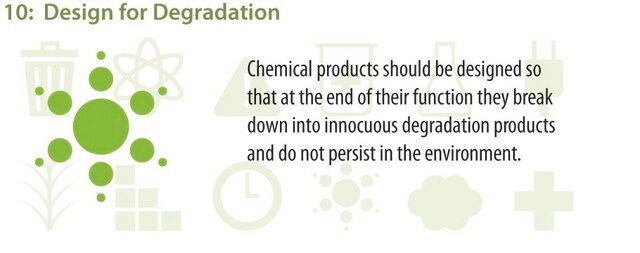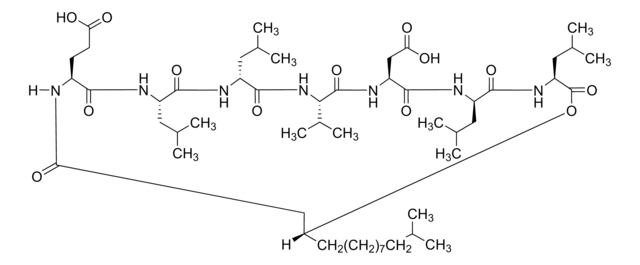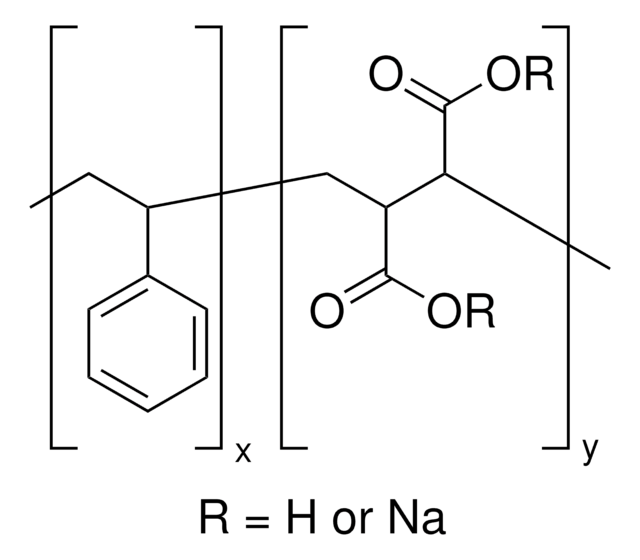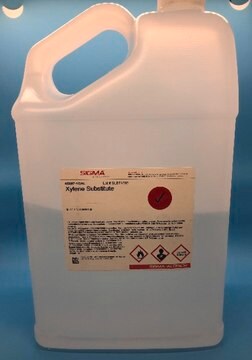R95M90
Rhamnolipids, 95% (90% Mono-Rhamnolipid)
Synonim(y):
Rhamnolipids
Zaloguj sięWyświetlanie cen organizacyjnych i kontraktowych
About This Item
Kod UNSPSC:
12352200
NACRES:
NA.22
Polecane produkty
pochodzenie biologiczne
Pseudomonas aeruginosa
Postać
solid/granular
Warunki transportu
ambient
temp. przechowywania
room temp
Szukasz podobnych produktów? Odwiedź Przewodnik dotyczący porównywania produktów
Opis ogólny
Rhamnolipid biosurfactants are glycolipids containing L-rhamnose and ß-hydroxyl fatty acids, with amphiphilic properties (both hydrophilic and hydrophobic). This rhamnolipid product has been purified from Pseudomonas aeruginosa and contains a mixture of rhamnolipids with fatty acids of varying tail length. They are highly biodegradable, non-toxic, and renewable. Functional roles include bioactive, surfactant and emulsifier. Rhamnolipids provide good detergency/foaming/wetting, stable microemulsion formation, and solubility under high alkalinity. They are mild with skin-friendly attributes. Surfactant and emulsion properties of rhamnolipids include reducing the surface tension of water to 25 to 40 mN/m, having a CMC of 5-380 mg/L, and decreasing the interfacial tension of oil and water to <1 dyne/cm. Rhamnolipid biosurfactants are superior to synthetic surfactants for several reasons: their CMC is 10-100 times lower than that of traditional chemical surfactants (meaning much less material is required to achieve reductions in surface tension/interfacial tension); they are easily biodegradable with very low toxicity (having higher EC50 values); they are not as affected by temperature, pH and salinity; and they are sustainably produced.
Zastosowanie
Rhamnolipids can be used in pharmaceuticals, cosmeceuticals, cosmetics, personal products, environmental bioremediation, the petroleum industry, household cleaners, food and beverage processing, agriculture and horticulture, therapeutics, nanotechnology, the polymer industry, cryo-protectants, the mining industry, biofuels, ethanol production, microbial fuel cells, protein research, and neural stem cell studies.
Informacje prawne
Product of AGAE Technologies
This page may contain text that has been machine translated.
Kod klasy składowania
13 - Non Combustible Solids
Temperatura zapłonu (°F)
Not applicable
Temperatura zapłonu (°C)
Not applicable
Certyfikaty analizy (CoA)
Poszukaj Certyfikaty analizy (CoA), wpisując numer partii/serii produktów. Numery serii i partii można znaleźć na etykiecie produktu po słowach „seria” lub „partia”.
Masz już ten produkt?
Dokumenty związane z niedawno zakupionymi produktami zostały zamieszczone w Bibliotece dokumentów.
Magdalena Pacwa-Płociniczak et al.
International journal of molecular sciences, 12(1), 633-654 (2011-02-23)
Increasing public awareness of environmental pollution influences the search and development of technologies that help in clean up of organic and inorganic contaminants such as hydrocarbons and metals. An alternative and eco-friendly method of remediation technology of environments contaminated with
Markus Michael Müller et al.
Journal of biotechnology, 162(4), 366-380 (2012-06-26)
The demand for bio-based processes and materials in the petrochemical industry has significantly increased during the last decade because of the expected running out of petroleum. This trend can be ascribed to three main causes: (1) the increased use of
Roger Marchant et al.
Biotechnology letters, 34(9), 1597-1605 (2012-05-24)
Glycolipid biosurfactants produced by bacteria and yeasts provide significant opportunities to replace chemical surfactants with sustainable biologically produced alternatives in bulk commercial products such as laundry detergents and surface cleaners. Sophorolipids are already available in sufficient yield to make their
[Factor VIII inhibitor postpartum].
I Ohkubo et al.
[Rinsho ketsueki] The Japanese journal of clinical hematology, 27(9), 1596-1602 (1986-09-01)
Metabolism of isoprenaline in the intestine.
C F George et al.
The Journal of pharmacy and pharmacology, 26(4), 265-267 (1974-04-01)
Nasz zespół naukowców ma doświadczenie we wszystkich obszarach badań, w tym w naukach przyrodniczych, materiałoznawstwie, syntezie chemicznej, chromatografii, analityce i wielu innych dziedzinach.
Skontaktuj się z zespołem ds. pomocy technicznej






